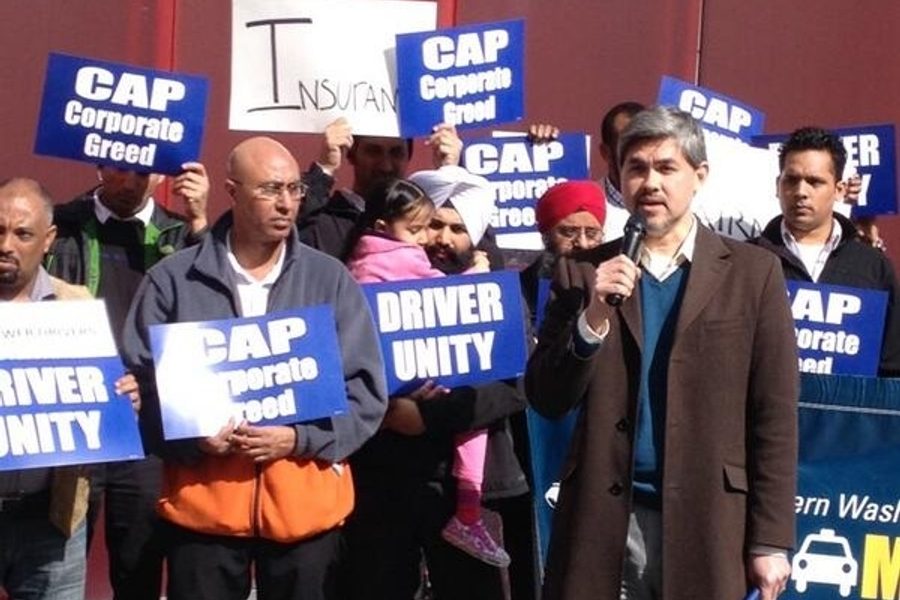
On Monday, the Seattle City Council voted unanimously to cap the number of rideshare drivers on the city streets. The rideshare companies Lyft, Uber and Sidecar, which pair drivers with riders through a web application service, were told they could each have no more than 150 drivers on the road at a given time, though there are no limits on how many vehicles or drivers they can have in their system. The new law is the first restriction placed on rideshare companies in Seattle that have been competing against a taxi industry faced with licensing obligations, strict insurance requirements and operational taxes. The new companies, unfettered by such regulations, have built up a fleet of an estimated 2,000 drivers in Seattle over recent years, causing concern in the taxi industry among companies, unions and drivers that the rideshare boom will undercut them — and perhaps ultimately drive them out of business.
Seattle’s rideshare cap may be the first of its kind, but the city is not the first to put the brakes on the new web-based rideshare apps, also known as transportation network companies (TNC). TNC are banned from operation in New Orleans, Los Angeles, Miami, Austin and Portland, Ore. Currently, Chicago is considering whether to join Minneapolis, St. Paul, Milwaukee and Detroit in imposing taxi-like regulations on TNC, including a special license, a minimum insurance requirement and a transportation tax.
The Washington Post declared the Seattle vote “a major victory for the city’s taxi cab drivers.” Taxi companies such as Yellow Cab and individual drivers lobbied in favor of the new regulations, which, in addition to thinning the rideshare herd, will bring the web-based companies in line with state insurance requirements. To make up for the reduced number of transportation vehicles, the new legislation will, for the first time since 1990, issue new taxi licenses — 200 of them.
But some taxi drivers aren’t celebrating the vote.
Joe Blondo, who has been driving a cab since 1987 and who was present at Monday’s city council meeting, considers the vote a defeat for taxi drivers because it “basically legitimized all the illegal activity of the for-hire and rideshare companies” that have been undercutting taxi drivers. “We’ve been obeying all the rules, paying all the fees,” he says.
Blondo considers himself a “major player” in the Seattle taxi scene. A longtime driver, he maintains a blog called “Real Seattle Taxi,” and at one point served as the chair of the Seattle-King County Taxi Advisory Commission, established to advise the county on taxi industry issues.
Those issues, Blondo says, extend beyond rideshare. Before there was rideshare, there were “flat-rate for-hire” companies, which arrange rides in advance and charge an hourly or flat rate. Less regulated and thus more competitively priced than traditional taxis, for-hire vehicles are only authorized to take passengers by prearrangement. But even before the convenience of rideshare smartphone apps reduced the prearrangement rule to a mere bump in the road, for-hire vehicles were already weaving their way around it, painting their cars like taxis and sometimes doing illegal curbside pickups. Blondo says it amounts to “poaching” rides from legitimate taxi drivers. “We’d been asking for over three years for the City of Seattle to stop this and they didn’t. So that’s part one. And then you have the rideshare companies come in … and now we’re even worse off.”
In a February statement , Seattle City Councilman Tim Burgess who was opposed to the cap but ultimately voted in favor, wrote that for-hire and rideshare companies have been operating “to-date by ignoring and violating City laws. This sets a dangerous precedent and is a lesson for the executive branch of City government to address these issues as soon as they emerge….That being said, the question before the Council today is what to do now.” And in deciding on next steps, Burgess argues that the economic importance of the jobs and services that rideshare companies provide in Seattle precludes banishing them altogether.
Though Seattle taxi drivers are not members of a formal union, they spent two years lobbying the city for rideshare regulations with the help of Teamsters Local 117. A spokesperson for the local, Paul Zilly, had a mixed reaction to the legislation, calling it a “step in the right direction,” but warning that, “now that the new regulations are in place, it’s the city’s job to hold rideshare companies accountable when they break the law.” He also cited numerous weaknesses in the law, saying, “It is unfortunate that there was no cap on the [total] number of vehicles or drivers, no cap on the number of TNC companies, and most of all that TNC companies have been given increased leverage over the TNC drivers who are already at an extreme disadvantage.”
Blondo believes the new legislation was a step toward creating a two-tiered cab system — with licensed taxis on one side and underregulated TNCs on the other. The law, he says, sends a negative message to traditional taxi drivers that the mainstream press has overlooked. “The City Council decided that the years of illegal operation by both parties [were] unimportant, unworthy of any penalty or fine, telling us to essentially ‘suck it up’ and accept the inevitable,” he wrote on his blog on Monday.
The “inevitable” to which he refers is the end of the taxi system as we know it. Proponents of rideshare services argue that this is simply the free market doing its job: Ridesharing companies have developed a better business model. According to JP Mangalindan at CNNMoney,
Passengers more and more appear to appreciate these startups’ superior dispatch technology, ease of use, and competitive pricing. …Indeed, the lack of a central taxi dispatch has long meant some taxis are never connected with some passengers, a frustrating scenario businesses like Uber sidestep with smartphone apps that track the car’s location on a virtual map and an ETA. Meanwhile pricing is becoming cutthroat: Late last week, Uber slashed Uber X prices again in 16 cities, including San Francisco, by up to 34 percent, claiming fare prices cheaper than traditional cabs.
And the new platform appeals to drivers, too, who often use their own cars (meaning no sunk costs if they’ve rented the car and then come down with the flu), and many attest to greater flexibility in managing their work schedule. The San Francisco Cab Drivers Association reported that in 2013, one-third of the city’s taxi drivers left their registered cab to drive for Lyft, Sidecar, or Uber.
Sean McConnell, a freelance audio-engineer by trade, has been driving for Lyft in Chicago since October for extra income. According to the company’s website, drivers like McConnell are “users of the platform and are not employees of the company.” But this works out for him: “I can use it as a part-time gig or full time depending on how much I want to work.” Like most Lyft drivers, McConnell uses his own car, but says that “Lyft is really supportive as far as what they’re willing to help you out with.”
But critics say that TNC are enjoying the benefits of operating outside the law, as well as the cushion of tens of millions in start-up capital from major investors like Amazon CEO Jeff Bezos, and using those perks to unfairly undermine the competition.
When I asked Blondo whether or not he would consider becoming a rideshare driver if the new service eventually replaced companies like Yellow Cab, his answer came immediately: “No. I’m a tried-and-true cab driver. It’s a professional job and they’ve deprofessionalized it.” In Chicago, for example, cab drivers (and even horse-drawn carriage operators) are required to pass the Public Chauffeur License Test, a skill and knowledge test that quizzes would-be drivers on all streets and major locations in the city. Rideshare drivers do not have to take this test.
While admitting that when he joined the fleet he was not required to undergo any training, Blondo feels that training should be a part of the career, and that casual rideshare drivers cannot effectively replace career cabbies.
The friction between the rideshare and taxi visions for the future of transportation in American cities like Seattle and Chicago is often reduced to a clash between workers. But their interests aren’t always divergent. Outside the Seattle City Hall on Monday, drivers from both sides of the debate participated in the pro-regulation “Driver Unity Rally,” according to the Teamsters 117 website.
Though the rally was sponsored by taxi companies, taxi associations and the Teamsters Local 117, which advocates for taxi drivers, the event was sponsored by two companies representing for-hire drivers, and it framed the debate in terms of what is best for workers. “All drivers — whether they drive a taxi, a for-hire vehicle, or an Uber towncar — deserve fair treatment and a living wage,” said Rich Stolz, Executive Director of the progressive non-profit OneAmerica, in an address to the rally. “The best way to achieve fairness is through safe, sensible regulation that puts workers and the traveling public first.”
Zilly says that the Teamsters “are going to continue to work to ensure that the rights of all workers in the industry are protected. All drivers deserve fair treatment and the ability to earn a living wage.”
And Blondo, for his part, promises we will see a lawsuit pretty soon and that he will be one of the people behind it, as long as the taxi companies don’t file first. “We’re going to try to get an injunction stopping the entire law… I’m already setting up an organizing meeting with other drivers for next week.”







